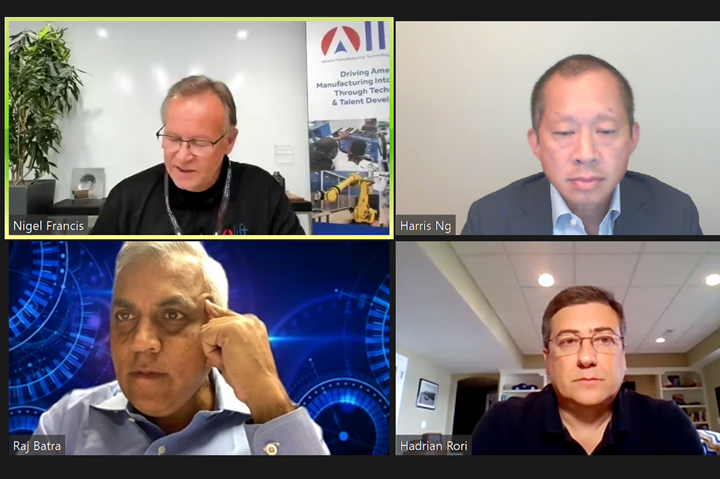CAR MBS: Manufacturing Ops Need Better Tech, Experts Say
Equipment needs updating—as do the personnel in the industry
#workforcedevelopment #economics #labor
Hadrian Rori, chief technology officer of LIFT, recalled a visit he made to the original Chrysler Jefferson Avenue Assembly Plant when he got out of school some 36 years ago. He said that it was everything that one imagines when they think “factory”—and not in a good way.
“There’s got to be a better way to build vehicles and parts,” he said he thought, and has continued to think ever since.

Francis (top left), Ng (top right), Batra (bottom left) and Rori (bottom right) all think manufacturing operations in the U.S. need more investment and must attract more young people.
Some of the things that he thinks will provide improvement are additive manufacturing (“It is going to revolutionize manufacturing in the future”); advanced analytical tools that allows a determination of material behavior at the molecular level; quality control tools that confirm that a good part is being made and AI that can modify process parameters to assure this occurs; and distributed manufacturing operations to produce products as close to point of use as possible.
Raj Batra, president of Digital Industries, Siemens USA, said quite simply, “The manufacturing infrastructure needs an upgrade.” He added, “We can’t get the productivity needed with technology that is 30+ years old.”
Batra said that the COVID-19 crisis is exposing the aging asset base that exists in manufacturing operations and that this has to be addressed.
Harris Ng, partner at Kearney, noted that for the past 25 years ago companies have been “focused on labor arbitrage,” chasing the lowest labor costs.
Now, he said, as a result of the challenges being presented by trade wars, the pandemic, and the USMCA, there is a need to deploy advanced manufacturing technology in order to improve labor productivity.
“There must be sufficient capital allocated to operations,” he said, adding, “now it is allocated mainly to products.”
As you can see, there is a recurrent idea here. The three were talking during “The State of Manufacturing” session at the 2020 CAR Management Briefing Seminars.
Moderator Nigel Francis, CEO of LIFT, encompassed what his colleagues stressed with three words: “Technology, talent and capital.”
The speakers all agreed that there needs to be a focus on what’s occurring in the industry, something that Batra colorfully described as “the Big Crew Change”—as in an increasing number of Baby Boomer retiring and being replaced—ideally—by a tech savvy younger cohort.
However, Ng noted that “Tesla aside, there is not a whole lot of people who want to go into an older manufacturing industry”—as in auto.
Even though the industry has come a long way since Rori first visited that Chrysler plant, there still exists a notion that automotive facilities (“Tesla aside”) are not the place to be for a young person.
Perhaps this goes back to the need to make more capital investments in manufacturing operations to make them more appealing.
RELATED CONTENT
-
On Quantum Navigation, EVs, Auto Industry Sales and more
Sandia’s quantum navi, three things about EVs, transporting iron ore in an EV during the winter, going underwater in an EV (OK, it is a sub), state of the UK auto industry (sad), why the Big Three likes Big Vehicles, and the future of logistics.
-
On Global EV Sales, Lean and the Supply Chain & Dealing With Snow
The distribution of EVs and potential implications, why lean still matters even with supply chain issues, where there are the most industrial robots, a potential coming shortage that isn’t a microprocessor, mapping tech and obscured signs, and a look at the future
-
On Lincoln-Shinola, Euro EV Sales, Engineered Carbon, and more
On a Lincoln-Shinola concept, Euro EV sales, engineered carbon for fuel cells, a thermal sensor for ADAS, battery analytics, and measuring vehicle performance in use with big data


.jpg;width=70;height=70;mode=crop)